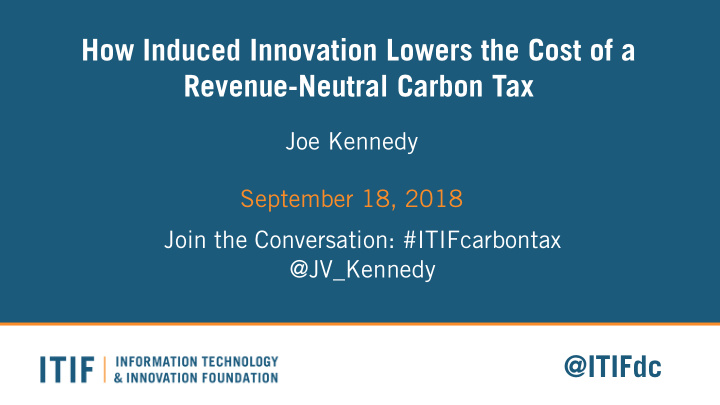



How Induced Innovation Lowers the Cost of a Revenue-Neutral Carbon Tax Joe Kennedy September 18, 2018 Join the Conversation: #ITIFcarbontax @JV_Kennedy @ITIFdc
Contents The Basics Behind a Carbon Tax 1 The Theory of Induced Innovation 2 Attempts to Model Induced Innovation 3 Using the Proceeds of a Carbon Tax 4 2
Why a Carbon Tax? Two ways to reduce CO2 emissions – Demand-side – Supply-side Basic tools – Regulatory limits – Cap-and-trade – Carbon tax 3
The Basics of a Carbon Tax Responds to the market failure resulting from the atmosphere’s status as a common resource Two Effects: 1. Producers and consumers switch to less carbon- intensive products and inputs 2. Companies invest in less carbon-intensive technology Also produces significant co-benefits 4
Contents The Basics Behind a Carbon Tax 1 The Theory of Induced Innovation 2 Attempts to Model Induced Innovation 3 Using the Proceeds of a Carbon Tax 4 5
Why We Need Innovation Most models of the optimal carbon tax come up with an initial tax of $10 to $20 per ton, which rises over time – This is too low to keep temperature rises under 2 ° C – Yet there is very little support for higher taxes or slower growth Significant reductions therefore depend upon rapid technological innovation 6
Theory of Induced Innovation Innovation responds directly to market changes in prices An increase in the relative price of an input will induce innovation directed at reducing the use of the input 7
How Induced Innovation Works 8
How Induced Innovation Works B A 9
How Induced Innovation Works 10
How Induced Innovation Works 11
Contents The Basics Behind a Carbon Tax 1 The Theory of Induced Innovation 2 Attempts to Model Induced Innovation 3 Using the Proceeds of a Carbon Tax 4 12
Lessons from the Oil Crisis and EPA Regulations Popp & Newell (2012) Higher prices caused R&D to shift from traditional fuels to alternatives Newell et al. (2004) Substantial relationship between energy prices and energy efficiency Induced innovation from higher fuel prices accounted for between 25-50 percent of increased energy efficiency Calel (2018) EU Emissions Trading System doubled low-carbon patents and quadrupled low- carbon R&D 13
Modeling Induced Innovation From a Carbon Tax Nordhaus (2004) Modest innovation effect Assumes 100% crowding out 14
Modeling Induced Innovation From a Carbon Tax Goulder and Mathai (2004) Lowers cost of abatement by about 30 percent Acemoglu et al. (2012) Optimal policy always involves both a tax and subsides for clean research 15
Modeling Induced Innovation From a Carbon Tax Popp (2004) Only measured increased fuel efficiency from existing fuels, not progress in alternative fuels Induced innovation increases the social welfare from a carbon tax by 9.4 percent but does not significantly increase the environmental benefits DiMaria and Smulders (2017) Shows that induced innovation can increase costs if firms cannot afford to invest in clean technology, especially if dirty technology is subsidized, so tax needs to be moderate and subsidies need to be phased out 16
Lessons Measurement requires many assumptions Induced innovation can reduce the cost of cutting emissions by up to 30 percent A tax plus a subsidy for adoption and/or research is most effective The optimal timing of a tax can depend on assumptions about how new technologies develop and spread 17
Contents The Basics Behind a Carbon Tax 1 The Theory of Induced Innovation 2 Attempts to Model Induced Innovation 3 Using the Proceeds of a Carbon Tax 4 18
What to Do with the Revenues? CBO: Tax of $25 per ton rising in real terms by 2% each year raises $977 billion over ten years 1. Rebates to users Pro: reduces economic impact on consumers Con: does nothing to spur long-term economic growth 2. Deficit reduction Pro: helps reduce national debt Con: does little to spur long-run economic growth 3. Business Tax Incentives Pro: spurs growth Con: concerns about regressivity and fairness 19
Business Tax Reductions CBO: Using carbon tax revenue to cut corporate taxes would cut the cost of reductions in half E&Y: Using tax to replace EPA regulations and lower corporate taxes would increase GDP by $3,000 per household Hafstead et al.: using a carbon tax to reduce corporate taxes increases social welfare 20
Better Approach: Incentives for More Business R&D Addresses another market failure, the fact that companies cannot capture all of the benefits of their research Reduces negative effect of business taxes Spurs productivity growth Public support for a tax is highest when at least part of the proceeds are used to fund clean energy research 21
Smart Tax Incentives: Increase ASC of R&D credit to 40 percent Apply credit to collaborative research outside the energy sector Establish an innovation box Make expensing of research costs permanent 22
Thank You! Joe Kennedy | jkennedy@itif.org | @JV_Kennedy @ITIFdc
Recommend
More recommend